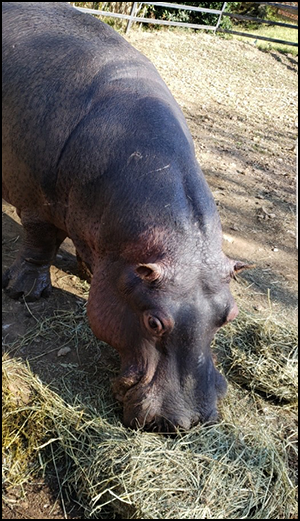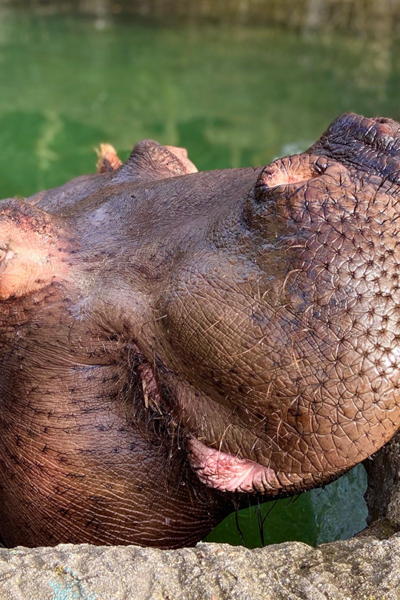Although Water’s Edge: Africa’s opening date hasn’t been set, Cheyenne Mountain Zoo is steadily preparing to welcome home Zambezi (zam-BEE-zee) and Kasai (kuh-SIGH), two female Nile hippopotamuses who are taking an extended vacation at Dickerson Park Zoo, in Springfield, Missouri. They moved there in 2016 to allow us to build a new state-of-the-art exhibit for them.
Patty Wallace, Water’s Edge: Africa lead animal keeper, worked with Zambezi and Kasai for six years at Cheyenne Mountain Zoo. Wallace spent five of those years as their primary trainer. She is excited for guests to get to know the girls again and to see them in their brand-new home.
Kasai is 20 years old and larger than her older sister, Zambezi. Kasai is easily identifiable by the pink spots on the tops of all four of her feet. Zambezi is 27 years old and has a more consistent skin tone than Kasai. Both hippos enjoy participating in training, but Kasai tends to have a more dominant personality, which often means she’s the first to investigate new enrichment or food.

“I’m really excited about rekindling our relationship and getting to know the hippos again,” said Wallace. “We can expect them to be a little cautious coming into this new building, because they’ve never been there before. Part of the challenge is getting them back to the level of comfort they had before. They’re both really food motivated, so I expect it will take a lot of patience, understanding and watermelon to help the girls gain confidence in their new space and with keepers again.”
Only 30 organizations accredited by the Association of Zoos and Aquariums in North America house hippos. In addition to their somewhat rare presence in zoos, Wallace says part of the CMZoo hippos’ appeal is their generally calm and gentle demeanors.
“Hippos are known as one of the most dangerous animals in the world, with incredibly impressive strength and size,” said Wallace. “Zambezi and Kasai have grown up in human care, so they’re used to people. They may scuffle with each other from time to time, but they really are gentle giants.”
A big part of helping the hippos gain confidence in their new home is training the keepers to control the myriad of new building features that will help them care for Zambezi and Kasai. Keepers are getting accustomed to underwater shift doors, hydraulic doors, garage doors, cable-and-bollard systems, water filtration systems, heating and cooling systems, lighting, behind-the-scenes kitchen and enrichment preparation areas, and more.
“We’re also planning our animal demonstrations and enrichment activities, considering how the girls might like to interact with us in this space and what will give our guests a memorable experience,” said Wallace. “We have a ton of opportunities to help guests fall in love with hippos, thanks to the design of this awesome new space.”
Water’s Edge: Africa’s indoor hippo demo space allows guests to get right up close to the hippos, with only bollards in between them and the animals. In the same area, guests can stand on a scale that helps them see how many humans it takes to weigh the same as a hippo. Near the outdoor hippo yard, a nature trail takes guests to a rope bridge that hangs above the hippo yard, giving guests a first-time bird’s eye view of the girls in water and on land. A knife-edge outdoor pool will help guests see the hippos as the hippos see them – just above the water line.
“You can be eye-level with a basking hippo at the knife-edge pool’s viewing area,” said Wallace. “It is going to be such a cool experience. I can’t wait for everyone to visit the new exhibit and hopefully form long-lasting relationships with these beautiful girls.”
At Dickerson Park Zoo, keepers are working with the girls to make them as comfortable as possible for their trip home to CMZoo, including building the hippos’ comfort level with their transport crates.
“We situated their transport crates so they’re part of the entrance to their yard, which allows them to travel through them and be around them regularly,” said Tracy Campbell, senior zookeeper at Dickerson Park Zoo. Campbell has worked with the girls since they arrived in 2016 and has worked with hippos for 20 years. “Once we have an exact timeline for their trip back to Cheyenne Mountain Zoo, we’ll increase their crate training time, but for now we’re keeping them acclimated by walking through them.”
Wallace was part of the transport training when the girls first traveled to Springfield.
“We trained with them for about three months before their last transport,” said Wallace. “They traveled in separate crates made of wood and steel. Like Dickerson Park Zoo is doing, we positioned the crates as entrances to the building, so they could walk through them and gain confidence with them over time. They were hesitant at first, but since they’re so food motivated, it didn’t take them long to get the hang of it.”
The trip between Dickerson Park Zoo and Cheyenne Mountain Zoo takes about 11 hours. The hippos travel in their crates inside an enclosed and climate-controlled flatbed truck. Once the hippos are comfortably in their crates, a large crane is used to move the 1.5-ton animals onto the truck. During the transport, the hippos are monitored to address any needs along the way. All went smoothly last time, and CMZoo keepers stayed with the girls at DPZ for about a week to help them settle in.
“I’m excited to have the girls home again,” said Wallace. “In the mornings, I would call ‘good morning, hippos!’ and they’d vocalize and poke up out of the water to look for me. They’d watch and wait for me to prepare their breakfast – and they’d let me know if I was being too slow. They’d walk up the ramp and stare at me, watching my every move. I can’t wait to see them and our guests exploring this amazing new exhibit.”
About Nile Hippos
The International Union for Conservation of Nature (IUCN) Red List categorizes Nile hippopotamuses as a species vulnerable to extinction in the wild, estimating 125,000 to 150,000 remain in their native habitats. The primary threats are habitat loss and illegal and unregulated hunting. Hippos are hunted for ivory, which is found in hippopotamuses’ canine teeth, and meat.

